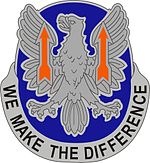11th Theater Aviation Command
| 11th Aviation Command | |
|---|---|

11th Aviation Command shoulder sleeve insignia
|
|
| Active | 1 February 1963 – present |
| Country | United States |
| Allegiance | Regular Army/Army Reserve |
| Branch | Army Aviation |
| Type | Composite Command |
| Role | Control of all Army Reserve aviation assets. |
| Garrison/HQ | Fort Knox, Kentucky |
| Motto(s) | "We Make the Difference" |
| Insignia | |
| Identification symbol |
 |
Army Reserve Aviation Command (ARAC) is the headquarters command for all aviation assets in the United States Army Reserve. It is a commanded by a Brigadier General and consists of approximately 5,000 Soldiers.
As of 2017 the following units are subordinated to the Army Reserve Aviation Command:
The ARAC was activated in its current formation on 16 September 2016. The unit's lineage traces to the prior lineage and shoulder sleeve insignia in the active component of the 11th Aviation Group, which was last headquartered in Illesheim, Germany in 2004.
The 11th Aviation Command incorporates the history of the 11th Aviation Group which can be traced to the 11th Airborne Division, which served in the Pacific Theater during World War II and in the Army of Occupation in Japan after the war. The division returned to the United States in May 1949 and established its headquarters at Fort Campbell, Kentucky. The Angels moved to Germany in 1956 and subsequently inactivated on 1 July 1958 when it was reflagged as the 24th Infantry Division. The 24th temporarily retained a partial Airborne capability to include the 1st Airborne Battle Group, 187th Infantry; the 1st Airborne Battle Group, 503rd Infantry; and the 11th Quartermaster Company, a parachute rigger unit. Within a year 1–187th and 1–503rd rotated to Fort Bragg, North Carolina, to become part of the 82nd Airborne Division while the rigger company relocated to the 8th Infantry Division in Mainz, where a new Airborne component was being formed within the division.
The colors remained dormant until the requirement for air mobility (heliborne tactical movement) of infantry units was established by the Department of the Army in 1962. Secretary of the Army Cyrus R. Vance envisioned that the Army required its own organic aviation assets to meet immediate combat needs of infantry units. The XVIII Airborne Corps began experimenting with this new concept by using borrowed helicopters. By the end of the year, Secretary Vance decided to form a test division to further evaluate this new concept.
...
Wikipedia
